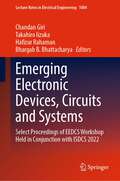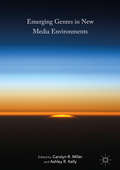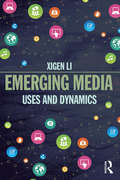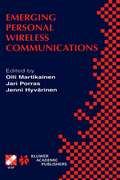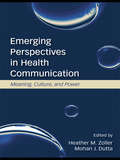- Table View
- List View
The Emerging Domain of Cooperating Objects
by Stamatis Karnouskos Daniel Minder Aníbal Ollero Pedro José MarronThere are a number of different system concepts that have gained much relevance in the area of embedded systems over the past couple of years. First, there is the classic concept of embedded systems where the focus is on control systems for physical processes. Secondly, the notion of pervasive computing has evolved, where the vision foresees everyday objects having some form of computation capacity and, in most cases, sensing and communication facilities. Thirdly, the notion of wireless sensor networks has arisen, where small computing devices are able to sense their environment and cooperate in order to achieve a well-defined goal. These three types of quite diverse systems share a lot of commonalities on the one hand and, on the other hand, have some complementary aspects in common that make a combination of these systems into a coherent system vision promising. In particular, the important notions of control, heterogeneity, wireless communication, dynamic and ad-hoc nature and cost are prevalent to various degrees in each of these systems. A future system concept needs to combine the strong points of all three system concepts in at least these functional aspects. It has to provide support for the control of physical processes like today’s embedded systems do, have as good support for device heterogeneity and spontaneity of usage as required by pervasive and ubiquitous computing approaches, and has to be as cost efficient and wirelessly agile as wireless sensor networks are. These new systems consist, therefore, of individual entities or objects that jointly strive to reach a common goal, which will typically be a goal in sensing or control, and are dynamically and loosely federating themselves for cooperation, taking care not to overtax their available resources. This book presents a roadmap to these concepts which are summarized as cooperating objects.
The Emerging Domain of Cooperating Objects: Definitions and Concepts (SpringerBriefs in Electrical and Computer Engineering)
by Pedro José Marrón Daniel Minder Stamatis KarnouskosThis book provides a classification of current and future applications for the domain of Cooperating Objects. The book has been created with a very strong participation of the industry and taking into account current research trends and industrial roadmaps
Emerging Electronic Devices, Circuits and Systems: Select Proceedings of EEDCS Workshop Held in Conjunction with ISDCS 2022 (Lecture Notes in Electrical Engineering #1004)
by Chandan Giri Takahiro Iizuka Hafizur Rahaman Bhargab B. BhattacharyaThe book constitutes peer-reviewed proceedings of a workshop on Emerging Electronics Devices, Circuits, and Systems (EEDCS) held in conjunction with International Symposium on Devices, Circuits, and Systems (ISDCS 2022). The book focuses on the recent development in devices, circuits, and systems. It also discusses innovations, trends, practical challenges, and solutions adopted in device design, modeling, fabrication, characterization, and their circuit implementation with pertinent system applications. It will be useful for researchers, developers, engineers, academicians, and students.
Emerging Electronics and Automation: Select Proceedings of E2A 2021 (Lecture Notes in Electrical Engineering #937)
by Peter Han Joo Chong Akhtar Kalam Antonio Pascoal Manas Kumar BeraThis book constitutes peer-reviewed proceedings of the International Conference on Emerging Electronics and Automation (E2A) 2021. The book presents new ideas, research findings, and novel techniques in the fields of sensors and instrumentation, automation and control, artificial intelligence, MEMS sensors, soft computing, signal processing, and communication. It includes contributions received from both academia and industry. The proceedings will be helpful for beginners as well as advanced researchers in the area of automation and other allied fields.
Emerging Genres in New Media Environments
by Carolyn R. Miller Ashley R. KellyThis volume explores cultural innovation and transformation as revealed through the emergence of new media genres. New media have enabled what impresses most observers as a dizzying proliferation of new forms of communicative interaction and cultural production, provoking multimodal experimentation, and artistic and entrepreneurial innovation. Working with the concept of genre, scholars in multiple fields have begun to explore these processes of emergence, innovation, and stabilization. Genre has thus become newly important in game studies, library and information science, film and media studies, applied linguistics, rhetoric, literature, and elsewhere. Understood as social recognitions that embed histories, ideologies, and contradictions, genres function as recurrent social actions, helping to constitute culture. Because genres are dynamic sites of tension between stability and change, they are also sites of inventive potential. Emerging Genres in New Media Environments brings together compelling papers from scholars in Brazil, Canada, England, and the United States to illustrate how this inventive potential has been harnessed around the world.
Emerging Genres in New Media Environments
by Carolyn R. Miller Ashley R. KellyThis volume explores cultural innovation and transformation as revealed through the emergence of new media genres. New media have enabled what impresses most observers as a dizzying proliferation of new forms of communicative interaction and cultural production, provoking multimodal experimentation, and artistic and entrepreneurial innovation. Working with the concept of genre, scholars in multiple fields have begun to explore these processes of emergence, innovation, and stabilization. Genre has thus become newly important in game studies, library and information science, film and media studies, applied linguistics, rhetoric, literature, and elsewhere. Understood as social recognitions that embed histories, ideologies, and contradictions, genres function as recurrent social actions, helping to constitute culture. Because genres are dynamic sites of tension between stability and change, they are also sites of inventive potential. Emerging Genres in New Media Environments brings together compelling papers from scholars in Brazil, Canada, England, and the United States to illustrate how this inventive potential has been harnessed around the world.
Emerging Location Aware Broadband Wireless Ad Hoc Networks
by Rajamani Ganesh Ramón Agustí Sastri L. Kota Kaveh PahlavanEmerging Location Aware Broadband Wireless Ad Hoc Networks is a compilation of new material on wireless networking and technology addressing several technical challenges in the field. The contributions are authored by distinguished experts who presented experimental results on their work at the recent International Symposium on Personal, Indoor, Mobile, Radio Communications (PIMRC) held in Barcelona, Spain, September 5-8, 2004. The authors present new results on issues involving wireless LANs and ad hoc networks; mobile wireless internet and satellite applications; encoding, algorithms and performance; and issues related to overlay networks, cross layer interactions and smart antennas. Whether you’re a telecommunications/networking specialist, systems engineer or a scientist, Emerging Location Aware Broadband Wireless Ad Hoc Networks provides valuable insight from experts in wireless networking for developing wireless systems and meeting future application requirements.
Emerging Media: Uses and Dynamics
by Xigen LiEmerging Media provides an understanding of media use in the expanding digital age and fills the void of existing literature in exploring the emerging new media use as a dynamic communication process in cyberspace. It addresses emerging media dynamics during the second decade of online communication, the Web 2.0 era after Mosaic and Netscape. The current status of emerging media development calls for extended exploration of how emerging media are used in different patterns and contexts, and this volume answers that call: it is a comprehensive examination of emerging media evolution and concurrent social interaction. This collection: Provides a comprehensive analysis of digital media use and online communication with empirical data Contains both theoretical and empirical studies, which not only test communication and related theories in the age of digital media, but also provide new insights into important issues in digital media use and online communication with significant theoretical advances Spotlights studies that use a variety of research methods and approaches, including surveys, content analysis and experiments This volume will be invaluable to researchers of communication and new media, and will serve advanced undergraduate and graduate students studying media and digital communication. With an international scope, it appeals to readers around the world in all areas that utilize new media technologies.
Emerging Media: Uses and Dynamics
by Xigen LiEmerging Media provides an understanding of media use in the expanding digital age and fills the void of existing literature in exploring the emerging new media use as a dynamic communication process in cyberspace. It addresses emerging media dynamics during the second decade of online communication, the Web 2.0 era after Mosaic and Netscape. The current status of emerging media development calls for extended exploration of how emerging media are used in different patterns and contexts, and this volume answers that call: it is a comprehensive examination of emerging media evolution and concurrent social interaction. This collection: Provides a comprehensive analysis of digital media use and online communication with empirical data Contains both theoretical and empirical studies, which not only test communication and related theories in the age of digital media, but also provide new insights into important issues in digital media use and online communication with significant theoretical advances Spotlights studies that use a variety of research methods and approaches, including surveys, content analysis and experiments This volume will be invaluable to researchers of communication and new media, and will serve advanced undergraduate and graduate students studying media and digital communication. With an international scope, it appeals to readers around the world in all areas that utilize new media technologies.
The Emerging Monoculture: Assimilation and the Model Minority (Non-ser.)
by Eric KramerKramer brings together experts from a variety of minority backgrounds and from around the world to give their perspectives on the most pervasive ideology today, globalism. The basic premise is that a developed country is different from a developed community. They need not be mutually exclusive, but neither is it assumed that they are necessarily consonant.The various essays offer answers to such vital questions as What does it mean to become a 'global citizen'? and What does it mean to be a 'model minority' in a global economy? The process of becoming a mainstream person involves being first marginalized with the implication that something is inadequate about one's self. The process of assimilationism is manifested as various forms of enforced and/or rewarded acculturation. With the vast human migration currently underway, the notion of assimilation has become a global phenomenon. What is occurring, Kramer and his colleagues demonstrate, is a worldwide shift from the village milieu to the city lifestyle. This migration is seen as a polycentric and global phenomenon whereby the promised land is nowhere in particular, but, instead, a way of life and mindset, an urban lifestyle. This process is far more than a simple change in geography. Moving from the village to the cityscape involves a mutation in worldview and self-identity. Additional questions asked throughout the collection are What set of persuasive assumptions are leading the world in this direction? and What might be lost in the process? A provocative collection for scholars, students, and other researchers involved with development studies, multiculturalism, and urbanization.
Emerging Optical Network Technologies: Architectures, Protocols and Performance
by Krishna M. Sivalingam Suresh SubramaniamOptical networks have moved from laboratory settings and theoretical research to real-world deployment and service-oriented explorations. New technologies such as Ethernet PON, traffic grooming, regional and metropolitan network architectures and optical packet switching are being explored, and the landscape is continuously and rapidly evolving. Some of the important issues involving these new technologies involve the architectural, protocol, and performance related issues. This book addresses many of these issues and presents a birds eye view of some of the more promising technologies. Researchers and those pursuing advanced degrees in this field will be able to see where progress is being made and new technologies are emerging. Emerging Optical Network Technologies: Architectures, Protocols and Performance provides state-of-the-art material written by the most prominent professionals in their respective areas.
Emerging Personal Wireless Communications: IFIP TC6/WG6.8 Working Conference on Personal Wireless Communications (PWC’2001), August 8–10, 2001, Lappeenranta, Finland (IFIP Advances in Information and Communication Technology #67)
by Olli Martikainen Jari Porras Jenni HyvärinenThe growth of telecommunications has been largely based on mobile and data services in the past 10 years and the growth will continue. For instance, it is forecasted that after 2005 the mobile traffic turnover in Europe will exceed that of fixed telephone traffic and the penetration of Internet access through mobile will exceed that of fixed access. It is expected that the new value added services will be Internet-based and the IP traffic will outweigh the amount of traditional ISDN based telephone traffic. The transition from the existing telecommunications services to mobile and Internet based ones will change the service infrastructure as well as the customer and service management structures. In wireless communications there are several new standards being developed and implemented to improve the data transmission rate over radio channels, to combine both voice, packet data and multimedia services in the terminals and to improve the service quality and usability. Narrow band packet radio standards such as General Packet Radio Service (GPRS) and i-Mode are already operative and broadband IMT-2000 standards, also called as Third Generation (3G) Mobile, have been developed in Japan, Europe and US. At the same time Wireless LAN and Bluetooth technologies mature and provide short-range data access to terminal devices. The emerging new technologies create opportunities not only to incumbent teleoperators but also to new network operators, IT companies and new service and content providers.
Emerging Perspectives in Health Communication: Meaning, Culture, and Power
by Heather Zoller Mohan J. DuttaThis volume provides the theoretical, methodological, and praxis-driven issues in research on interpretive, critical, and cultural approaches to health communication. It includes an international collection of contributors, and highlights non-traditional (non-Western) perspectives on health communication.
Emerging Perspectives in Health Communication: Meaning, Culture, and Power (Leas Communication Ser.)
by Heather Zoller Mohan J. DuttaThis volume provides the theoretical, methodological, and praxis-driven issues in research on interpretive, critical, and cultural approaches to health communication. It includes an international collection of contributors, and highlights non-traditional (non-Western) perspectives on health communication.
Emerging Practices in Science and Technology Librarianship
by Amy BesnoyThis book investigates the emerging practices of science and technology librarians specific to maintaining collections, providing access to resources, and ensuring that informed decisions are made regarding limited financial resources. Issues discussed include librarians becoming embedded in curriculum design and delivery, the continuum of librarian involvement, science literacy and the intersection with lifelong learning, integration of information literacy into science, technology, engineering and mathematics (STEM) curriculum, development of course-related instruction programs. In addition, chapters include the differentiation between locating and accessing content and the economics of access, data driven collection and retention decisions, social networking and the scientific community, the trend to merge IT with libraries, institutional repositories, and managing productivity.Each chapter considers the change that is occurring in and around the profession and together these chapters present a notable set of reflections on the changes that are necessary for science and technology librarians to thrive in the shifting information landscape. This book is recommended for scholars and professional librarians.This book was published as a special issue of the Journal of Library Administration.
Emerging Practices in Science and Technology Librarianship
by Amy L. BesnoyThis book investigates the emerging practices of science and technology librarians specific to maintaining collections, providing access to resources, and ensuring that informed decisions are made regarding limited financial resources. Issues discussed include librarians becoming embedded in curriculum design and delivery, the continuum of librarian involvement, science literacy and the intersection with lifelong learning, integration of information literacy into science, technology, engineering and mathematics (STEM) curriculum, development of course-related instruction programs. In addition, chapters include the differentiation between locating and accessing content and the economics of access, data driven collection and retention decisions, social networking and the scientific community, the trend to merge IT with libraries, institutional repositories, and managing productivity.Each chapter considers the change that is occurring in and around the profession and together these chapters present a notable set of reflections on the changes that are necessary for science and technology librarians to thrive in the shifting information landscape. This book is recommended for scholars and professional librarians.This book was published as a special issue of the Journal of Library Administration.
Emerging Practices in the Age of Automated Digital Journalism: Models, Languages, and Storytelling (Routledge Research in Journalism)
by Berta García-Orosa Sara Pérez-Seijo Ángel VizosoEmerging Practices in the Age of Automated Digital Journalism provides a detailed insight into the current state of journalism and its future challenges. The book brings together a global team of authors to review and analyse emerging practices in the automated digital scenario through which journalism is being reshaped, such as novel languages, storytelling forms, and business models. Providing a much-needed review of the field to apprehend the knowledge and experience acquired, the collection also offers an up-to-date overview of digital journalism today, outlining those trends pointing to the future of journalism practice and media in the online sphere. Through a multidisciplinary and international approach, chapters delve into the main technological changes that digital journalism has recently faced, closely related to digital native media, novel storytelling forms, social media, innovation, television broadcasting, new media management structures and procedures, content automation, fact-checking, web analytics, and social audiences. Offering new insights into this fast-developing area, this volume will be an engaging and vital resource for media professionals and researchers in journalism and communication studies, as well as those interested in contemporary journalism practice and communication technology.
Emerging Practices in the Age of Automated Digital Journalism: Models, Languages, and Storytelling (Routledge Research in Journalism)
by Berta García-Orosa Sara Pérez-Seijo Ángel VizosoEmerging Practices in the Age of Automated Digital Journalism provides a detailed insight into the current state of journalism and its future challenges. The book brings together a global team of authors to review and analyse emerging practices in the automated digital scenario through which journalism is being reshaped, such as novel languages, storytelling forms, and business models. Providing a much-needed review of the field to apprehend the knowledge and experience acquired, the collection also offers an up-to-date overview of digital journalism today, outlining those trends pointing to the future of journalism practice and media in the online sphere. Through a multidisciplinary and international approach, chapters delve into the main technological changes that digital journalism has recently faced, closely related to digital native media, novel storytelling forms, social media, innovation, television broadcasting, new media management structures and procedures, content automation, fact-checking, web analytics, and social audiences. Offering new insights into this fast-developing area, this volume will be an engaging and vital resource for media professionals and researchers in journalism and communication studies, as well as those interested in contemporary journalism practice and communication technology.
Emerging Radiation Detection: Technology and Applications
by Kris Iniewski Harish GadeyThis book provides readers an overview of emerging trends in the radiation detection field. Detailed in many of the chapters are specific aspects of radiation detectors, including comprehensive reviews of the historical development, and current state of each topic. The authors particularly cover emerging detection materials and detectors. High-Z materials like CdTe, CZT and GaAs offer the best implementation possibility of direct conversion X-ray detectors and are covered in this book. The authors discuss material challenges, detector operation physics and technology, and readout integrated circuits required to detect signals processes by high-Z sensors. Authors also contrast these emerging technologies with more established ones based on scintillator materials.
Emerging Research in Computing, Information, Communication and Applications: ERCICA 2020, Volume 2 (Lecture Notes in Electrical Engineering #790)
by N. R. Shetty N. Nalini L. M. Patnaik H. C. Nagaraj Prasad N. HamsavathThis book presents the proceedings of International Conference on Emerging Research in Computing, Information, Communication and Applications, ERCICA 2020. The conference provides an interdisciplinary forum for researchers, professional engineers and scientists, educators and technologists to discuss, debate and promote research and technology in the upcoming areas of computing, information, communication and their applications. The book discusses these emerging research areas, providing a valuable resource for researchers and practicing engineers alike.
Emerging Research in Computing, Information, Communication and Applications: ERCICA 2020, Volume 1 (Lecture Notes in Electrical Engineering #789)
by N. R. Shetty L. M. Patnaik H. C. Nagaraj Prasad N. Hamsavath N. NaliniThis book presents the proceedings of International Conference on Emerging Research in Computing, Information, Communication and Applications, ERCICA 2020. The conference provides an interdisciplinary forum for researchers, professional engineers and scientists, educators and technologists to discuss, debate and promote research and technology in the upcoming areas of computing, information, communication and their applications. The book discusses these emerging research areas, providing a valuable resource for researchers and practicing engineers alike.
Emerging Research in Computing, Information, Communication and Applications: ERCICA 2018, Volume 1 (Advances in Intelligent Systems and Computing #882)
by N. R. Shetty L. M. Patnaik H. C. Nagaraj Prasad Naik Hamsavath N. NaliniThis book presents selected papers from the International Conference on Emerging Research in Computing, Information, Communication and Applications, ERCICA 2018. The conference provided an interdisciplinary forum for researchers, professional engineers and scientists, educators, and technologists to discuss, debate and promote research and technology in the emerging areas of computing, information, communication and their applications. The book discusses these research areas, providing a valuable resource for researchers and practicing engineers alike.
Emerging Research in Computing, Information, Communication and Applications: ERCICA 2018, Volume 2 (Advances in Intelligent Systems and Computing #906)
by N. R. Shetty L. M. Patnaik H. C. Nagaraj Prasad Naik Hamsavath N. NaliniThis book presents selected papers from the International Conference on Emerging Research in Computing, Information, Communication and Applications, ERCICA 2018. The conference provided an interdisciplinary forum for researchers, professional engineers and scientists, educators, and technologists to discuss, debate and promote research and technology in the emerging areas of computing, information, communication and their applications. The book discusses these research areas, providing a valuable resource for researchers and practicing engineers alike.
Emerging Research in Computing, Information, Communication and Applications: Proceedings of ERCICA 2022 (Lecture Notes in Electrical Engineering #928)
by N. R. Shetty L. M. Patnaik N. H. PrasadThis book presents the proceedings of the International Conference on Emerging Research in Computing, Information, Communication and Applications, ERCICA 2022. The conference provides an interdisciplinary forum for researchers, professional engineers and scientists, educators, and technologists to discuss, debate, and promote research and technology in the upcoming areas of computing, information, communication, and their applications. The book discusses these emerging research areas, providing a valuable resource for researchers and practicing engineers alike.
Emerging Research in Computing, Information, Communication and Applications: ERCICA 2016
by N. R. Shetty L. M. Patnaik N. H. Prasad N. NaliniThis book presents the proceedings of International Conference on Emerging Research in Computing, Information, Communication and Applications, ERCICA 2016. ERCICA provides an interdisciplinary forum for researchers, professional engineers and scientists, educators, and technologists to discuss, debate and promote research and technology in the upcoming areas of computing, information, communication and their applications. The book discusses these emerging research areas, providing a valuable resource for researchers and practicing engineers alike.


